Gas Pipelines Regulations 2002
I, the Governor in and over the State of Tasmania and its Dependencies in the Commonwealth of Australia, acting with the advice of the Executive Council, make the following regulations under the Gas Pipelines Act 2000 .
28 October 2002G. S. M. GREEN
Governor
By His Excellency's Command,
P. A. LENNON
Minister for Economic Development, Energy and Resources
PART 1 - Preliminary
These regulations may be cited as the Gas Pipelines Regulations 2002 .
These regulations take effect on the day on which their making is notified in the Gazette.
In these regulations, unless the contrary intention appears –Act means the Gas Pipelines Act 2000 ;AS 2885 means AS 2885, Pipelines – Gas and liquid petroleum published by the Standards Association of Australia, as in force from time to time (including any code or standard having effect under that standard);AS 4360 means AS 4360, Risk management published by the Standards Association of Australia, as in force from time to time (including any code or standard having effect under that standard);AS 4801 means AS 4801, Occupational health and safety management systems – Specification with guidance for use published by the Standards Association of Australia, as in force from time to time (including any code or standard having effect under that standard);licensee means the holder of a pipeline licence;safety and operating plan means a safety and operating plan for a pipeline accepted or provisionally accepted under Division 2 of Part 3 of the Act;safety case means a safety case or revised safety case for a pipeline facility that is accepted or provisionally accepted under Division 3 of Part 3 of the Act.
PART 2 - Application for pipeline licence
4. Application for licence to construct or operate pipeline
(1) For the purposes of section 11(1)(d) of the Act, an application for a pipeline licence to construct a pipeline must specify –(a) the anticipated date of commencement of the construction of the pipeline; and(b) the expected date of completion of that construction; and(c) the anticipated date of commissioning the pipeline; and(d) a description of the route of the proposed pipeline with a map showing the proposed route of the pipeline and any significant landmarks drawn to a scale of 1:25 000 or such other scale as the Director of Gas may approve; and(e) a full description of the proposed pipeline, stating its length, pipe specifications, types and diameter with particulars of any pumping stations and ancillary works.(2) For the purposes of section 11(1)(d) of the Act, an application for a pipeline licence to operate a pipeline must specify –(a) the anticipated date of commencement of the operation of the pipeline; and(b) a full description of the proposed pipeline, stating its length, pipe specifications, types and diameter with particulars of any pumping stations and ancillary works.(3) For the purposes of section 11(1)(f) and section 11(2)(b) of the Act in so far as that section applies to a pipeline licence to construct or operate a pipeline, the prescribed fee is 5 000 fee units in each case.(4) Before the transmission of gas for the purposes of sale may be undertaken, the applicant for the relevant pipeline licence and the Director of Gas Safety must both comply with the requirements specified in Schedule 3 relevant to the construction, commissioning and operation of the pipeline.
5. Application for licence to construct or operate pipeline facility
(1) For the purposes of section 11(1)(e) of the Act, an application for a pipeline licence to construct or operate a pipeline facility must specify –(a) the anticipated dates for the commencement and completion of construction and for the commissioning and the commencement of operation of the pipeline facility; and(b) a full description of the proposed pipeline facility and of the purposes for which it will be used.(2) For the purposes of section 11(1)(f) and section 11(2)(b) of the Act in so far as that section applies to a pipeline licence to construct or operate a pipeline facility, the prescribed fee is 5 000 fee units in each case.
PART 3 - Safe operation of regulated activities
6. Records of compliance audits
(1) In this regulation,prescribed records means records maintained by the licensee for the purposes of section 33 of the Gas Pipelines Act 2000 of the Act (including, in the case of a record kept by means of a computer, a print-out of the record).(2) A licensee must make available, in accordance with subregulation (3) , copies of prescribed records, on written or oral request, to the Director of Gas Safety or an authorised officer.Penalty: Fine not exceeding 30 penalty units.(3) The licensee must make the copies of records available –(a) as soon as practicable during the following times:(i) in the case of emergency on, or in respect of, the pipeline or pipeline facility, at any time (including night-time) on any day;(ii) in any other case, during normal business hours on any day, other than a Saturday, a Sunday or a statutory holiday; and(b) either at the place where the records are maintained or, by agreement with the person making the request, at any other place or by means of electronic transmission.(4) For the purpose of enabling documents to be made available in accordance with this regulation, the licensee must –(a) notify the Director of Gas Safety, in writing, of a telephone number within Australia at which a request may be made in accordance with this regulation and notify the Director, in writing, as soon as practicable of any change in that telephone number; and(b) ensure that arrangements are in place for calls made for the purpose of this regulation to be received and acted on at that number, at any time (including night-time) on any day.Penalty: Fine not exceeding 30 penalty units.
PART 4 - Safety requirements for pipelines
7. Prescribed standards for pipeline
For the purposes of sections 47(1) , (3) and 49(1) of the Act, the prescribed standards and codes are as specified in Schedule 1 .
PART 5 - Contents of Safety Case
8. Core matters affecting safety of pipeline facility
(1) The safety case in respect of a pipeline facility must include –(a) a description of the pipeline facility as mentioned in subregulation (2) ; and(b) a formal safety assessment as mentioned in subregulation (3) ; and(c) a safety management system as mentioned in subregulation (4) –each of which –(d) is in place, or is to be put in place, for the pipeline facility; and(e) complies with the relevant provisions of this regulation.(2) A facility description in respect of a pipeline facility must –(a) contain a description of the pipeline facility (including the method of operation and the layout and design features that are complementary to the control measures identified as a result of a formal safety assessment); and(b) provide for all control measures to be used for the pipeline facility; and(c) be consistent with the formal safety assessment in respect of the pipeline facility.(3) A formal safety assessment in respect of a pipeline facility must contain –(a) an identification of all hazards having the potential to cause an incident; and(b) a detailed and systematic assessment of risk, in accordance with AS 4360, including the likelihood and consequences of an incident; and(c) a description of technical and other measures undertaken, or to be undertaken, to reduce the level of risk to as low as reasonably practicable; and(d) a description of technical and other measures implemented, or to be implemented, to assess and minimise the likelihood and consequences of an incident; and(e) a description of the design and layout of equipment and hardware, including the use of protective devices, so as to ensure that the risks to persons involved with the pipeline facility are reduced to a level as low as reasonably practicable.(4) A safety management system in accordance with AS 4801 in respect of a pipeline facility must make provision for –(a) activities that will, or are likely to, take place at, or in connection with, the pipeline facility; and(b) the regular and systematic identification of hazards related to the pipeline facility; and(c) the regular and systematic assessment of –(i) the likelihood of the occurrence, during normal or emergency situations, of injury or damage associated with those hazards; and(ii) the likely nature of such injury or damage; and(d) as far as reasonably practicable, the elimination or reduction of risks to any person which may arise from the pipeline facility and, in particular –(i) risks arising during evacuation, escape and rescue in case of emergency; and(ii) risks to persons involved with the pipeline facility; and(e) where the safety case identifies inspection and maintenance of, and testing programs for, equipment and hardware as integral to the control of those risks, the requisite inspection, maintenance and testing programs; and(f) criteria and information demonstrating that other risks to the safety of the pipeline facility and to persons at it have been reduced to a level as low as reasonably practicable; and(g) communications systems that, in the event of an emergency, are adequate for communication –(i) within a facility; and(ii) with any other facility which may be affected by the emergency; and(iii) with the relevant fire authorities and emergency service authorities; and(iv) any remote or isolated persons who may be affected by, or exposed to, conditions existing at the facility; and(h) any other information that is reasonably necessary to demonstrate that the safety management system meets the requirements of these regulations and AS 4801; and(i) performance standards applicable to the safety management system.
9. Additional matters affecting safety of pipeline facility
(1) A safety case must specify the systems of monitoring, auditing and reviewing the implementation of the safety policies, procedures and performance standards specified in the safety case, so as to demonstrate the methods of –(a) ensuring the ongoing effectiveness of those systems by –(i) continual and systematic identification of deficiencies in those systems; and(ii) continual and systematic improvement of those systems; and(b) implementing the safety management system specified in the safety case.(2) The safety case in respect of a pipeline facility must adequately specify all relevant standards to be applied in the design, construction, installation, commissioning and operation of the pipeline facility or plant, equipment and hardware used on, or in connection with, the pipeline facility.(3) The safety case in respect of a pipeline facility must specify an office or position at the pipeline facility, the occupant of which, while on duty –(a) is in charge of the pipeline facility; and(b) is responsible for the safe operation of the pipeline facility.(4) The safety case in respect of a pipeline facility must describe the means of ensuring, as far as reasonably practicable, that –(a) the office or position referred to in subregulation (3) is continuously occupied while the pipeline facility is in operation; and(b) the person for the time being in occupation of that office or position is competent, by reason of having the necessary skills, training and ability, to perform the functions of a person in charge of the pipeline facility; and(c) the identity (by reference to office or position) of the person in charge of the pipeline facility can at all times be readily ascertained, by means of a notice displayed in accordance with subregulation (6) , by any person actually at the pipeline facility; and(d) the identity (by reference to office or position) of the person responsible for giving effect to the safety case, and for any revision of the safety case which may be necessary or expedient from time to time, can at all times be readily ascertained.(5) The safety case in respect of a pipeline facility must describe the means of ensuring that, at all times –(a) there is in place a command structure that applies in the event of any emergency; and(b) the command structure and identity of all persons involved are clearly set out in a notice displayed in accordance with subregulation (6) .(6) For the purposes of subregulation (4)(c) and subregulation (5)(b) , a notice must be –(a) prominently displayed at the pipeline facility; and(b) easily legible.(7) The safety case in respect of a pipeline facility must provide for the communications systems of the facility to be –(a) adequate to handle a likely emergency at, or relating to, the facility and the operation requirements of the facility; and(b) protected so as to be capable of operation in an emergency to the extent specified by the risk assessment relating to the facility.(8) The safety case in respect of a pipeline facility must provide that each employer or employee working at, or in connection with, the pipeline facility is to be competent, by reason of having the necessary skills, training and ability –(a) to undertake –the tasks, both routine and non-routine, that may reasonably be allocated to him or her; and(i) in normal operating conditions; and(ii) in abnormal or emergency conditions; and(iii) during any changes to or modifications of the pipeline facility –(b) to respond and react appropriately, and at the level reasonably required of him or her, during an emergency.(9) The licensee of a pipeline facility must keep, in the manner and for the period specified in the safety case in force for the pipeline facility, documents required by the safety case to be kept, including in particular the following documents:(a) the safety case in force for the pipeline facility;(b) any revisions of the safety case;(c) any written audit reports of the safety case;(d) a copy of all information given by the operator of the pipeline facility to the Director of Gas Safety for the purposes of the Act.
10. Permit to work system for safe performance of various activities
(1) The safety case in respect of a pipeline facility must provide for the licensee of the facility to establish and maintain, in accordance with subregulation (2) , a documented system of coordinating and controlling the safe performance of all work activities of persons at the facility, including in particular –(a) welding and other hot-work; and(b) cold-work (including physical isolation); and(c) electrical work (including electrical isolation); and(d) entry into, and working in, a confined space; and(e) procedures for working over water.(2) The system must –(a) form part of the safety management system specified in the safety case in force for the pipeline facility; and(b) identify the persons having responsibility to authorise and supervise work; and(c) ensure that all persons carrying out work at the facility are competent in the application of the system of work provided by subregulation (1) .
(1) The licensee of a pipeline facility must demonstrate to the reasonable satisfaction of the Director of Gas Safety that –(a) in the development or revision of the safety case in respect of the pipeline facility, there has been effective consultation with, and participation by, each class of persons involved with the pipeline facility, including in particular relevant employees; and(b) the safety case in respect of the pipeline facility provides adequately for effective consultation with, and effective participation by, those classes of persons so that they are able to arrive at informed opinions about the risks and hazards to which they may be exposed at the facility.(2) A demonstration for the purposes of subregulation (1) must be supported by adequate documentation.(3) In this regulation, a reference to relevant employees is taken to be a reference to employees who are –(a) identifiable before the safety case in respect of the pipeline facility is developed; and(b) working, or likely to be working, at the relevant pipeline facility.
12. Design, construction, installation, maintenance and modification
(1) The safety case in respect of a pipeline facility must specify an effective means of ensuring the adequacy of design, construction, installation, maintenance and modification of the pipeline facility, including its structural integrity.(2) In particular, the design, construction, installation, maintenance and modification of the pipeline facility must provide for –(a) adequate means of inventory isolation and pressure relief in the event of an emergency; and(b) adequate means of gaining access for servicing and maintenance of the pipeline facility and machinery and other equipment at the pipeline facility; and(c) adequate means of maintaining the structural integrity of the pipeline facility; and(d) taking into account the results of the formal safety assessment relating to the pipeline facility as mentioned in regulation 8(1)(b) .
13. Medical and pharmaceutical supplies and services
The safety case in respect of a pipeline facility must specify the medical and pharmaceutical supplies and services, sufficient for an emergency situation, that must be maintained at, or in respect of, the pipeline facility.
(1) The safety case in respect of a pipeline facility must specify the equipment required at the facility (including processing equipment, machinery and electrical and instrumentation systems) that relates to, or may affect, the safety of the facility.(2) The equipment must be fit for its function or use –(a) in normal operating conditions; and(b) to the extent that it is intended to function, or be used, in an emergency.
15. Evacuation, escape and rescue
(1) The safety case in respect of a pipeline facility must contain, or refer to, an evacuation and escape analysis in relation to the facility that specifies adequate routes for evacuation and escape in the event of an emergency.(2) For the purposes of subregulation (1) , the safety case must specify –(a) appropriate evacuation and escape analyses, and strategies for the control of evacuation and escape procedures; and(b) the position or office of the person responsible for implementing and supervising procedures in the event of an emergency.(3) The safety case must provide, in its evacuation and escape analysis, for the pipeline facility to have or contain amenities of the following kinds for the evacuation and escape of persons at the facility in the event of an emergency:(a) suitable evacuation and escape routes that are, as far as reasonably practicable, to be kept freely passable at all times;(b) in respect of any route that is not freely passable, suitable alternative arrangements;(c) suitable equipment for evacuation and escape;(d) suitable means of escape for use in the event of an emergency.
16. Measures concerning fire and explosion hazards
(1) A safety case in respect of a pipeline facility must contain a fire risk analysis specifying –(a) likely fire or explosion hazards to the facility; and(b) measures for detecting those hazards; and(c) measures for eliminating or reducing those hazards.(2) In particular, the analysis must consider –(a) the incorporation into the facility of both automatic and manual systems for the detection, control and extinguishment of –(i) outbreaks of fire; and(ii) leaks or escapes of gas; and(b) the means of isolating and safely storing hazardous substances, such as fuel, explosives and chemicals, that are used or stored at the facility; and(c) an analysis of evacuation and escape measures for use in the event of fire or explosion on the facility.(3) The design of the pipeline facility must take into account the results of the analysis.(4) The safety case must provide for each person who is at a pipeline facility when an escape drill or a fire drill is held in respect of the pipeline facility to take part in the drill.
The safety case in respect of a pipeline facility must specify adequate provision for the facility, in the event of an emergency, in respect of –(a) back-up power supply; and(b) lighting; and(c) alarm systems; and(d) emergency shut-down systems.
(1) The safety case in respect of a pipeline facility must specify a response plan designed to provide for possible emergencies, the risk of which has been identified by a formal safety assessment as mentioned in regulation 8(3) or a safety management system as mentioned in regulation 8(4) .(2) The plan must –(a) ensure the safety of persons likely to be at the facility at the time of the emergency; and(b) specify the performance standards that it applies.(3) The safety case must specify adequate provision for escape drill exercises and fire drill exercises by persons at the facility.(4) In particular, those exercises must ensure that those persons will be trained to function in the event of emergency with an adequate degree of knowledge, preparedness and confidence concerning the relevant emergency procedures.(5) The safety case must provide for the licensee of the pipeline facility to ensure, as far as reasonably practicable, that escape drill exercises and fire drill exercises are held in accordance with the safety case relating to the facility.(6) The safety case in respect of a mobile pipeline facility must also specify systems that are adequate to –(a) shut down or disconnect, in the event of emergency, all operations at the facility that could adversely affect the safety of the facility; and(b) give appropriate audible and visible warnings of the shutting down or disconnecting of those operations.
19. Compliance with standards and codes
For the purposes of section 59 of the Act, the prescribed standards and codes with which the licensee must demonstrate compliance are specified in Schedule 2 .
PART 6 - Miscellaneous
20. Transmission of gas for commissioning
For the purpose of commissioning a pipeline, an applicant for a pipeline licence may transmit gas through the pipeline in accordance with any directions given by the Director of Gas or the Director of Gas Safety.
For the purposes of section 14(2)(a) of the Act, the prescribed rate for penalty interest is a rate equal to the Commonwealth official ten-year long-term bond rate as published by the Reserve Bank of Australia on the last business day of the months of March, June, September and December of each year plus 50% of that rate.
22. Appeal from decision on administrative review
(1) An appeal to the Minister under section 83 of the Act –(a) is to be made in writing within 14 days after the day on which the applicant is notified of the decision on the relevant administrative review; and(b) is to specify the reasons for the appeal.(2) The Minister may extend the period referred to in subregulation (1) for making an appeal.(3) The Minister must, by notice served on the appellant, notify the appellant of –(a) the decision made on the appeal; and(b) the findings on material questions of fact; and(c) the evidence or other material on which the findings are based; and(d) the reasons for the decision.
For the purposes of section 90(2) of the Act, the prescribed depth is 30 centimetres.
24. Information as to location of pipeline
(1) A licensee must provide a means whereby members of the public may readily obtain information as to the exact location of the pipeline.Penalty: Fine not exceeding 50 penalty units.(2) It is sufficient compliance with this regulation if the required information is available from the telephone number 1100 or from the following website:
http://www.dialbeforeyoudig.com.au
SCHEDULE 1 - Standards and Codes applicable to pipelines
Purpose | Standard | Structures | AS 1170, SAA loading code; | AS 4100, Steel structures code | Pressure vessels | AS 1210, Unfired pressure vessels; | AS 4343, Pressure equipment – Hazard levels; | AS 3788, Pressure equipment – In-service inspection | Pressure piping | AS 4041, Pressure piping; | AS 1697, Gas transmission and distribution systems; | AS 1978, Pipelines – Gas and liquid petroleum – Field pressure testing; | AS 2885, Pipelines – Gas and liquid petroleum; | ASME B31.3, Process piping; | CSA Z662, Oil and gas pipeline systems | Hazardous areas | AS 2430, Classification of hazardous areas; | AS 2865, Safe working in a confined space | Cathodic protection | AS 2832, Guide to the cathodic protection of metals | Electrical | AS 3000, Electrical installations; | AS 1020, The control of undesirable static electricity; | AS 4853, Electrical safety on metallic pipelines | Risk management | AS 3931, Risk analysis of technological systems – Application guide; | AS 4360, Risk management; | AS 4801, Occupational health and safety management systems – Specification with guidance for use |
SCHEDULE 2 - Standards and Codes applicable to pipeline facilities
Facility safety case consideration | Standard or code | Pipelines | AS 2885, Pipelines – Gas and liquid petroleum; | AS 1697, Gas transmission and distribution systems; | ASME B31.8, Gas transmission and distribution piping systems | Pressure piping | AS 4041, Pressure piping; | ASME B31.1, Power piping; | ASME B31.3, Process piping | Pressure systems | API 521, Guide for pressure-relieving and depressurising systems | Pressure vessels | AS 1210, Unfired pressure vessels; | AS 1271, Safety valves, other valves, liquid level gauges, and other fittings for boilers and unfired pressure vessels; | AS 2971, Serially produced pressure vessels | Electrical | AS 3000, Electrical installations; | AS 1076, Code of practice for selection, installation and maintenance of electrical apparatus and associated equipment for use in explosive atmospheres (other than mining applications) | Risk management | AS 3931, Risk analysis of technological systems – Application guide; | AS 4360, Risk management; | AS 4801, Occupational health and safety management systems – Specification with guidance for use |
SCHEDULE 3 - Procedure before construction, commissioning or operation of pipeline
1. In the following table –Director means the Director of Gas Safety;rehabilitate, in respect of land in or on which a pipeline is constructed, means recontour and profile the land to its condition existing before the construction of the pipeline but does not include revegetate.
Displayed and numbered in accordance with the Rules Publication Act 1953.
Notified in the Gazette on 6 November 2002
These regulations are administered in the Department of Infrastructure, Energy and Resources.
EXPLANATORY NOTE
(This note is not part of the regulation)
These regulations provide for –(a) requirements on applying for a pipeline licence; and(b) the safe operation of regulated activities; and(c) the contents of a safety case; and(d) standards and codes which the holder of a pipeline licence must comply with; and(e) information to be made available to prevent boring or excavation near a pipeline; and(f) appeals against decisions of the Director of Gas or the Director of Gas Safety; and(g) appeals against decisions of planning authorities relating to developments within relevant attenuation distances.






